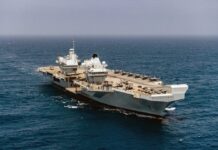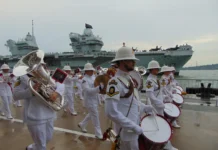
The first enlisted Australian sailors that could eventually crew American and Australian nuclear attack submarines graduated from the U.S. Navy’s Nuclear Power Training Unit, the service announced, the US Naval Institute reports.
Eight Royal Australian Navy sailors graduated from the six-month course on April 18 and are now qualified to handle the reactors and other associated systems on the nuclear attack boats that Canberra is set to receive under the 2021 Australia, United Kingdom and United States trilateral security agreement. The training, which began in the fall of 2024, included courses on mathematics, nuclear physics, reactor principles, and nuclear reactor technology.
“Having naval nuclear power-qualified officers, and now sailors, is critical in meeting our goal of operating conventionally armed, nuclear-powered submarines,” RAN Commodore Daniel Sutherland, commander RAN Submarine Force.
AUKUS, signed in 2021, formalized in 2023 and described by the Navy release as a “strategic initiative to reestablish deterrence in the Indo-Pacific region,” is set to provide the Royal Australian Navy with three Virginia-class boats, two Bloc IVs and one future Bloc VII, in the 2030s as a stop-gap measure. Five SSN-AUKUS, a new class of five nuclear attack submarines, are set to enter Australian service starting in the 2040s. Canberra will have the option of obtaining an additional two Virginias if this planned class falls behind schedule.
While five officers also completed their naval nuclear power training, they were preceded by two batches of three graduates each from 2023. After additional training in Connecticut, these officers were slated to embark on Hawaii-based Virginia-class nuclear attack boats to gain further operational experience.
“Six officers previously completed prototype training, each performing exceptionally well. I fully expect these recent graduates, especially our first enlisted personnel, will excel in the fleet,” said Capt. Robert Rose, Commander, NPTU Charleston, in a press release on the milestone event.
Nuclear power training was described as “the missing piece of the puzzle” by Vice Adm. Mark Hammond, a career submariner and the chief of the RAN, in his remarks to reporters last year at HMAS Stirling. Canberra’s existing fleet of Collins-class attack boats utilizes the same combat systems and weapons as the Virginias, but the sailors on the conventionally-powered boats have no experience with their reactors.
Training cooperation between U.S. and Australian submariners in the Indo-Pacific has ramped up in recent years. USS Emory S. Land (AS 39), one of two tenders capable of supporting submarines in the Navy’s fleet, received 37 Australian sailors last Spring in Guam to gain maintenance and experience knowledge from their American counterparts. This was ahead of the arrival of USS Hawaii (SSN-776) at HMAS Stirling, the Royal Australian Navy’s primary submarine base, and other activities designed to acclimate Australian sailors to their future platforms.
“These Royal Australian Navy sailors will now transition to our submarines to continue their training and qualifications in operating naval nuclear propulsion plants,” stated Master Chief Ed Jackson, Engineering Department Master Chief for Naval Reactors in a press release.


